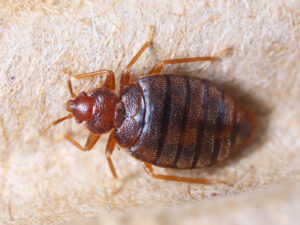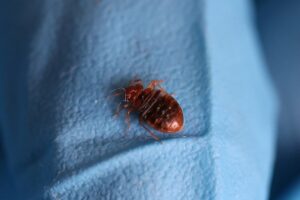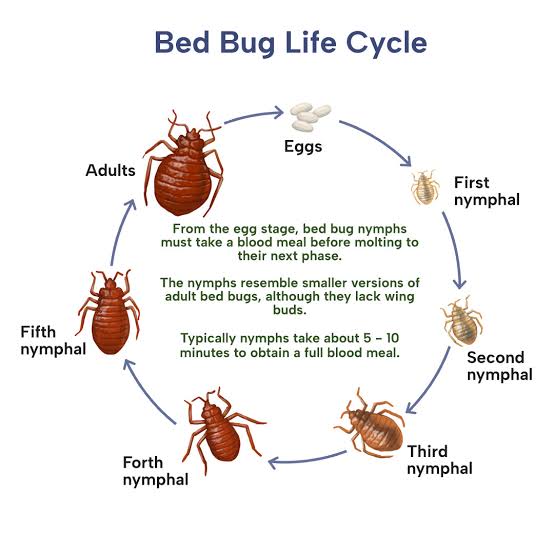Bed bugs (Cimex lectularius) are small, parasitic insects that can significantly disrupt the lives of residents in Dubai and beyond by feeding on blood, Initially native to Asia and Europe, these pests have spread globally due to increased travel and urbanization, making them a concern for Dubai’s diverse population.
Bed Bugs Biological Description
Biological Description of Bed Bugs based on the following:
- Size and Shape, Adult bed bugs measure between 4 and 5 millimeters in length, with a flattened, oval body that helps them hide in narrow spaces such as between floorboards or behind wallpaper.
- After feeding, they turn reddish-brown, while unfed specimens are light brown or yellowish.
- Antennae and Legs, Bed Bugs have segmented antennae with four segments that aid in detecting their environment. Their short but strong legs allow them to navigate various surfaces efficiently.
Life Cycle of Bed Bugs
- Eggs, Female bed bugs can lay between 200 and 500 eggs throughout their lifespan. These tiny, white eggs typically hatch within 6 to 10 days under ideal conditions.
- Nymphs, Upon hatching, bed bug nymphs are small and white, going through five developmental stages, each requiring a blood meal to advance. Nymphs molt their exoskeleton at each stage until reaching adulthood.
- Adults, Adult bed bugs can live for 6 to 12 months and potentially longer under optimal conditions. They can endure several months without feeding, allowing them to survive periods of food scarcity.

Behavior of Bed Bugs
- Feeding, Bed bugs primarily feed on human blood but can also consume the blood of other mammals, including pets. They use their mouthparts to pierce the skin and extract blood, with saliva that contains anticoagulants and anesthetics to facilitate feeding.
- Activity, Bed bugs are nocturnal and remain hidden during the day in cracks and crevices. Their activity is influenced by temperature and humidity levels.
Health Effects of Bed Bugs
- Skin Reactions, Bed bug bites can cause itching, redness, and swelling. In some cases, severe allergic reactions may occur, leading to blisters or sores.
- Excessive itching can result in scratching, increasing the risk of secondary infections.
- Diseases Although bed bugs are not major vectors for disease, their bites can lead to secondary infections from scratching, which may require medical treatment in severe cases.
Strategies for Bed Bug Control in Dubai
Regular inspections of furniture, clothing, and bedding are crucial for detecting bed bugs. This includes examining hidden areas for adult bugs, eggs, and nymphs.
Chemical Treatments
Pesticides can be effective against bed bugs but must be used with caution to avoid adverse health effects, proper usage and ventilation are critical after application.
- Cleaning and Isolation, Effective control measures involve washing and drying bedding and clothing at high temperatures. Using encasements for mattresses and pillows can also enhance protection.
- In severe infestations, professional pest control services may be necessary. These services may employ advanced techniques such as heat treatments or specialized insecticides.
Duration for Complete Bed Bug Eradication in Dubai
Efficiently addressing a bed bug infestation is essential due to the significant disruption these pests can cause. Common questions include: “How long does it take to completely eliminate bed bugs from a home?”
- Summary: Typically, eliminating bed bugs requires 2 to 4 treatment sessions over 3 to 6 weeks.
- The exact duration depends on the infestation’s severity and the property’s size.
- For a minor infestation in a studio apartment, one session (lasting 1 to 3 hours) may suffice.
- Extensive infestations across multiple rooms might need 3 to 4 or more sessions.

Effectiveness of Treatment
Pesticide treatments aim to kill most bed bugs within 1 to 3 hours. However, bed bugs often hide in hard-to-reach areas, so multiple treatments are usually necessary to ensure full eradication.
Potential for Reappearance
- Surviving bed bugs may become active soon after treatment.
- It’s important to monitor previously infested areas for any signs of continued activity.
- Regular inspections and sticky traps around bed legs can help in detecting any remaining pests.
Dormancy and Persistence
Bed bugs can remain dormant for over a year under ideal conditions, but this period is usually around six months in most homes. Exposure to freezing temperatures can kill bed bugs but is often impractical in Dubai’s climate.
Importance of Thorough Treatment
Thorough treatment and follow-up are crucial to prevent recurrence, Consulting with pest control professionals and implementing recommended measures can help achieve long-term success in eradicating bed bugs.
Scientific References:
- 1. Pinto, L. J., & Birtles, R. J. (2007). “Bed Bugs (Cimex lectularius) and their Impact on Public Health.” Journal of Environmental Health, 70(5), 16-20.
- Doggett, S. L., & Dwyer, D. E. (2011). “Bed Bugs: Clinical Impact and Treatment.” Clinical Microbiology Reviews, 24(3), 480-491.
- Romero, A., & Potts, S. G. (2011). “Understanding the Behavior of Bed Bugs and their Control Strategies.” Pest Management Science, 67(3), 348-357.
- Harris, S., & Wharton, G. (2012). “Bed Bugs: A Clinical Review.” American Journal of Clinical Dermatology, 13(4), 231-239.
In conclusion, managing a bed bug infestation in Dubai requires a comprehensive approach. By understanding their biology, behavior, and the appropriate control measures, residents can effectively address and prevent infestations, ensuring a comfortable living environment.




